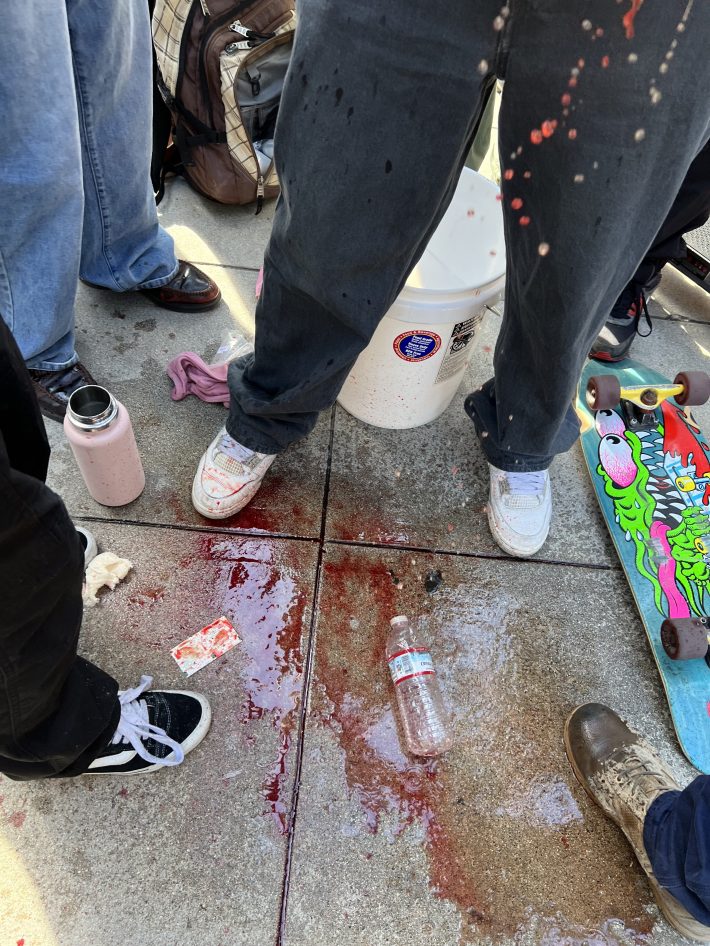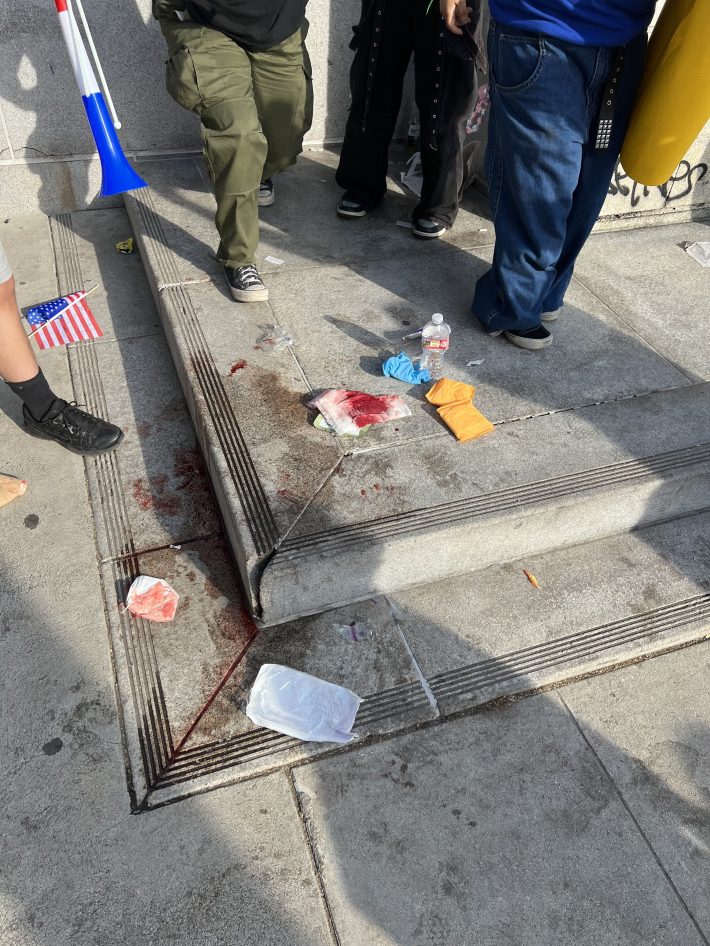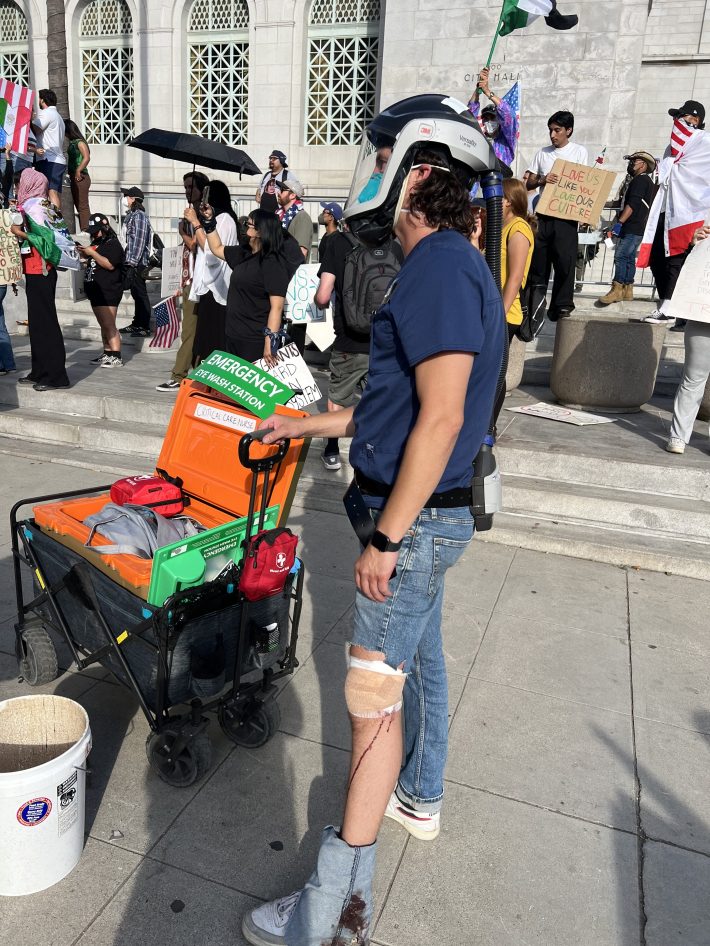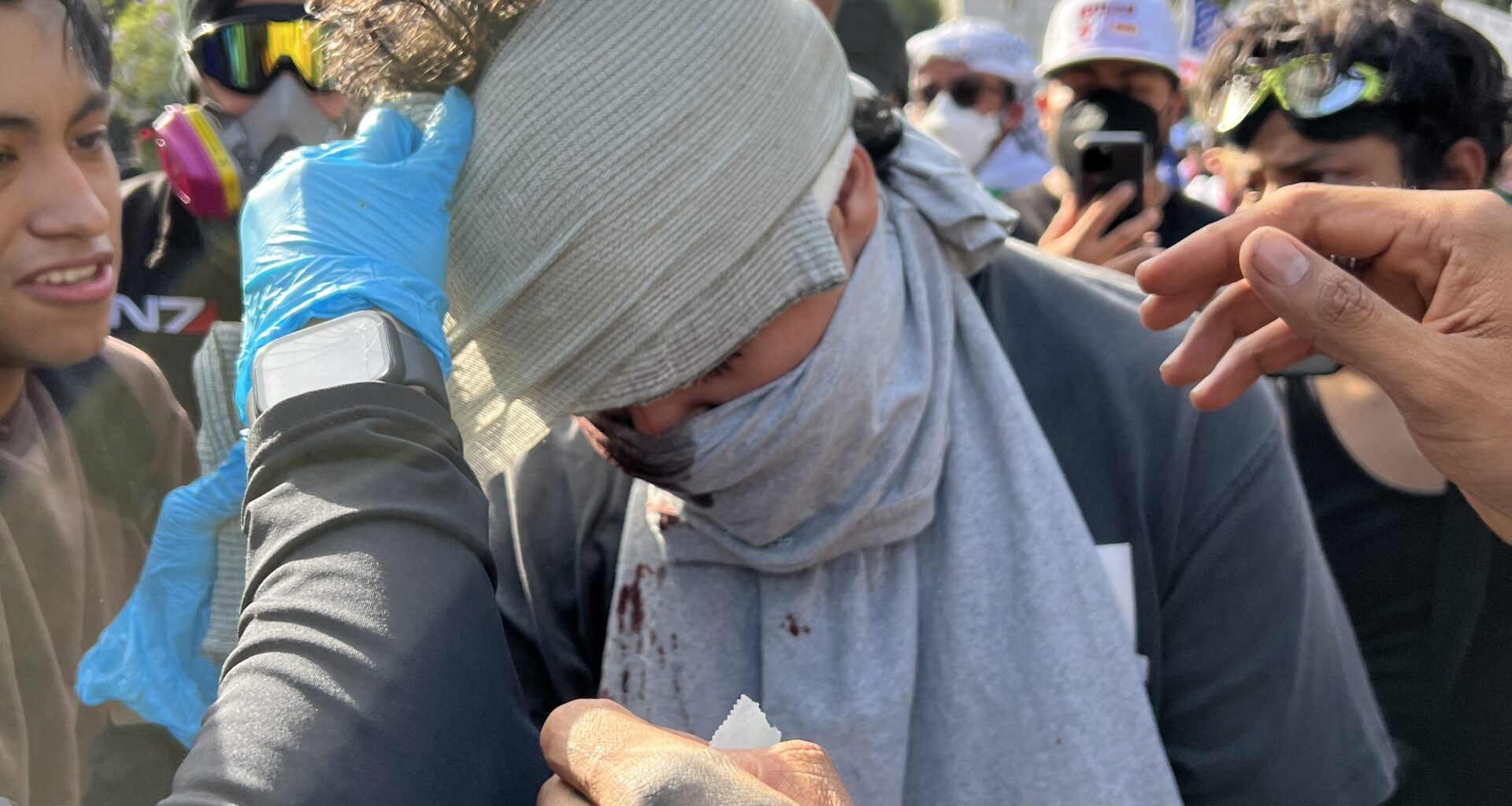Marty had been tear-gassed in Portland during the protests against George Floyd’s murder, stood up for refugees in Northern France, and marched through the streets of D.C. in 2020. But the most violent police forces she has ever encountered were here at home in Los Angeles.
“There’s something about Los Angeles police that just insinuates violence as a part of their job, and that’s fucking scary,” Marty told L.A. TACO during an interview earlier this month. “That is a scary distinction.”
Marty, who is using an alias for her own protection, experienced this violence first-hand from local law enforcement here in L.A. last month.
On June 14, like millions of other Americans, Marty hit the streets of Downtown Los Angeles for “No Kings Day,” a national protest against the Trump Administration.
The protest started off peacefully and relatively calmly.
But by mid-afternoon, Marty found herself outside of City Hall, looking for her friend, who was an ex-Army medic, dodging flash-bang grenades as they exploded around her.
Holding her ex’s “critical wound care” bag on Temple Street, hoping to pass it off to a volunteer medic amongst the demonstrators or anyone with the proper training to tend to the injured, Marty encountered a badly-wounded young man who she estimated was only 20 years old.
“His skin was flapped over,” she described. “Like he was injured so badly [he] was cut directly across his forehead and into his scalp, and his forehead skin was like flapped over.”
 A young man bleeds from their head onto the street outside of City Hall. Photo by Marty.
A young man bleeds from their head onto the street outside of City Hall. Photo by Marty.
Marty passed the medical supplies that she was carrying over to someone “who knew what they were doing,” while rubber bullets whizzed by her. By the time the young adult was bandaged up, the police began to use tear gas on the crowd, Marty said.
With a plastic bucket and water in hand, Marty stood on her knees trying to stop tear gas from emitting from a canister.
“I was on my knees with the bucket flipped over, over the tear gas, and I was pouring the water in,” she said.
Out of the corner of her eye, she noticed a Los Angeles sheriff’s deputy step out from a group of deputies.
“I kind of didn’t think anything of it, because he wasn’t looking at me at the time,” Marty explained. “So I look back at what I was doing … I was on my knees facing almost away from the guy, and then I just got blasted backwards.”
That’s when she took off running.
About half a block later, Marty realized that her goggles had been cracked, a sign that she was likely hit more than once.
Tear gas seeped in through her cracked goggles, making it nearly impossible for her to see where she was going.
“So I just grabbed onto somebody’s bag, and I said, ‘Can you please guide me? Guide me, guide me,’” she remembered.
The person walked her to safety and helped her wash out her eyes.
When the tear gas settled, Marty walked back to retrieve her bucket in the middle of the road.
“I went back and got my bucket, and I saw the [deputy] that I’m almost positive shot me,” Marty said. “And he was just smiling at me.”
 Blood from another head injury on June 14. Photo by Marty.
Blood from another head injury on June 14. Photo by Marty.
Marty was hit in her right breast with what she believes was a hard-foam projectile. It wasn’t until all of the adrenaline wore off that she realized how injured she was.
“When I finally got into [my] car, I looked down and the first, like, four layers of my nipple came off with my bra,” she said. “And then it was just blood. Just blood, blood, blood.”
The following day, Marty felt intense pains in her chest when she took deep breaths, almost as if she had broken a rib, she said. And she was left with a giant bruise on her breast that eventually turned so dark purple, it looked black.
The supposedly “less-lethal” munition also left her with an open wound that later turned into a scab.
“Anytime I wore a shirt, a bra, anything, [the scab] just got stuck to it and peeled right off,” she recalled.
Nearly a month after being shot, Marty still suffered from minor bruising.
“My boob is still yellow. It’s still going through the healing process at the moment, and everything is tender,” she said during an interview on July 10.
Sleeping through the night has become nearly impossible for Marty.
“I’m really looking forward to this part passing,” she said.
What separates law enforcement in L.A. from the police Marty had previously encountered in other U.S. cities and overseas is that they seem to enjoy hurting people, Marty said.
She recalled a time in Portland during the 2020 protests when police used tear gas and rubber bullets to disperse a crowd of people who were “sitting on their butts.”
“And this is still worse than that,” Marty said. “This is still so much more violent than that.”
“There’s so many actions being taken in L.A. that were not taken in any of the other places that I have been, even in Northern France, where French people are known to straight up burn down buildings and flip over cars and all that stuff,” Marty told L.A. TACO. “It didn’t get to this.”
Marty estimates that she saw dozens of injured protesters, many of them seriously injured, at the No Kings Day protest.
“I personally helped four different people with gaping wounds, like horrifically open wounds,” she said.
One of the people that Marty helped was a woman who had also been hit in the head.
“Her hair was split and her scalp was showing,” Marty recalled. “She was hurt. Hurt-hurt, and this was on the steps of City Hall.”
She also encountered another woman who was hit in the breast. “We compared injuries, and hers was visibly bad, like cuts and bleeding on the side,” Marty said.
 A street medic who was shot in the leg on June 14. Photo by Marty.
A street medic who was shot in the leg on June 14. Photo by Marty.
In addition to the people that she helped, Marty’s friend, who previously worked as an EMT in the Army, told her that “without exaggeration, he probably helped three dozen people with serious and minor injuries” that day. He himself was also injured.
In addition to protesters being injured, members of the media, medics, and also innocent bystanders who just happened to be in the wrong place at the wrong time were also shot, tear gassed, and injured by police during the No Kings Day protest.
Representatives for both the sheriff’s department and the LAPD have defended officers’ actions that day.
Spokespeople for both departments told the media that the protest remained peaceful during the morning and early afternoon. But by the mid-afternoon, a small number of protesters began throwing rocks, bottles, explosives, and other objects at officers. Dispersal orders were given, although many reporters and protesters told L.A. TACO that they did not hear the order, and eventually, police used cops mounted on horses, “less-lethal” projectiles, and tear gas to disperse thousands of people protesting in DTLA.
The police’s response to the No Kings Day protest and other anti-ICE protests over the past month and a half has resulted in multiple lawsuits seeking injunctions and/or millions of dollars, as well as harsh criticism from press freedom and civil rights advocates.
The LAPD says they are “investigating” more than 80 complaints against their officers related to the anti-ICE protests.
Marty says that the way law enforcement is responding to these protests sends a message to the public that says, “[the police] are not here to protect you.”
“[They] do not care if you live or die at the end of the day,” she says. “Because you don’t trample someone’s face with a horse and expect them to be okay after that. You don’t shoot someone in the head with a rubber bullet and expect them to be okay after that. You’re taking those actions because you know you are hurting somebody.”
“The message they’re sending to the public is, ‘if you disagree with us, we don’t care if you live or die.’”
